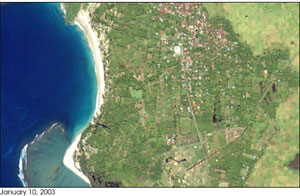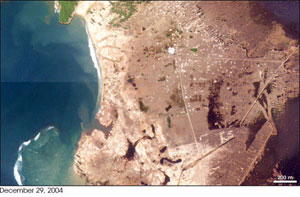Another large tsunami could hit Indonesia soon
Another large tsunami could hit Indonesia soon
mongabay.com
December 4, 2006
Researchers at the University of Southern California (USC) and California Institute of Technology (Caltech) say that the Indonesian island of Sumatra could be due for another large tsunami like the one that devastated the island on December 26, 2004. Their research is published in the December 4 Proceedings of the National Academy of Sciences.
Based on analysis of historical earthquakes, the researchers say that another tsunami produced from another giant earthquake is “likely to flood densely populated sections of western coastal Sumatra,” south of areas affected by the 2004 tsunami. The researchers note that the southeastern section of the same fault that caused the 2004 tsunami triggered giant quakes in the two great quakes and tsunamis in 1797 and 1833, and that “such events appear to recur on average every 230 years.”
  Tsunami Destroys Lhoknga, Indonesia: The Indonesian province of Aceh was hit hardest by the earthquake and tsunamis of December 26, 2004. Aceh is located on the northern tip of the island of Sumatra. The largest waves struck the northwestern coast of Sumatra. The town of Lhoknga, on the west coast of Sumatra near the capital of Aceh, Banda Aceh, was completely destroyed by the tsunami, with the exception of the mosque (white circular feature) in the city’s center. Credit: Ikonos images copyright Centre for Remote Imaging, Sensing and Processing, National University of Singapore and Space Imaging.. |
“The message of the 2004 tsunami has not been lost, at least in academia,” said study participant Costas Synolakis, the director of the USC Viterbi School of Engineering Tsunami Research Center. “We are trying to be proactive and help prevent a similar disaster.”
“When we tell people living along this 700-km section of the Sumatran coast that they will likely experience a big tsunami within the next 30 years, they ask for details. How much time after the earthquake will they have before the tsunami strikes? How big will the waves be? How far inland should they be prepared to run? What areas are likely to suffer tsunami damage?” said Kerry Sieh, professor of geology at the Caltech, and a co-author of the study. “We can’t answer these important questions without doing the work that we did for this paper… We hope that these initial results will help focus educational efforts, emergency preparedness activities, and changes in the basic infrastructure of cities and towns along the Sumatran coast.”
This article is based on a news release from PNAS.